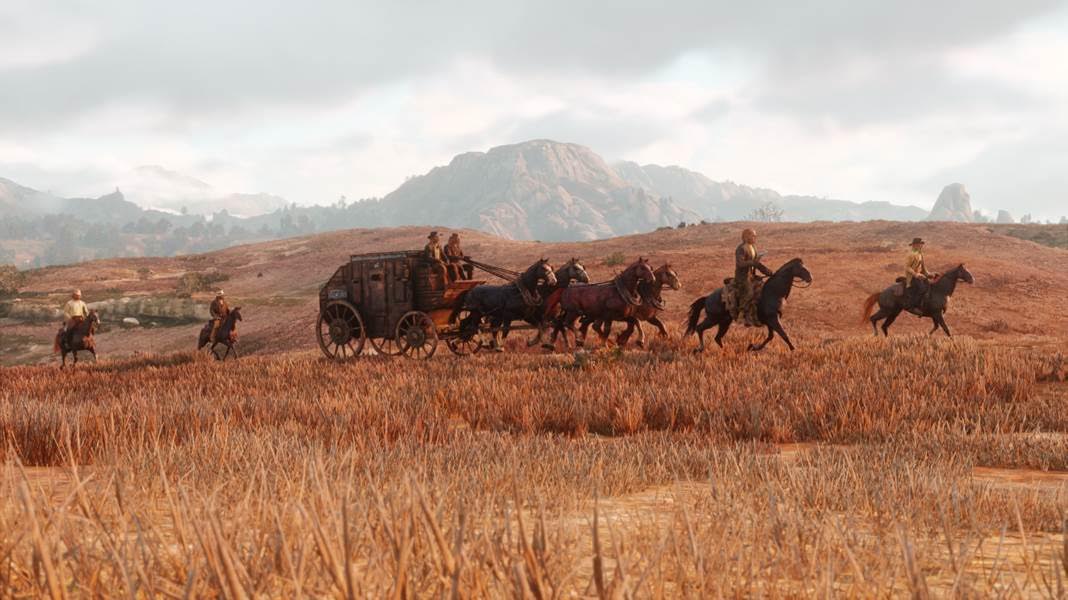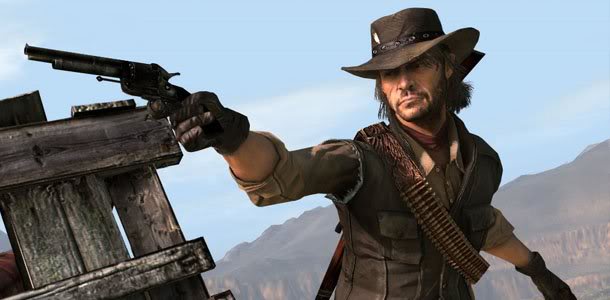Rob Nelson has spent 15 years at Rockstar Games, working on games such as The Warriors, the Grand Theft Auto series, and both Red Dead Redemption and Red Dead Redemption 2. For the past 3.5 years, he has been co-head of the Rockstar studio in Edinburgh, Scotland.
But he’s really been living in the Wild West for the better part of a decade.
Nelson is one of the people who brought us Red Dead Redemption 2, one of the most ambitious story-driven open world games ever made. Red Dead Redemption 2 was in development for eight years. More than 2,000 artists, designers, writers, programmers, and others contributed to it. Analysts believe it could hit 20 million copies sold by the end of December, a level of sales that would make it an enduring hit. Only a handful of games like this will ever get made, in my assessment. It set a new bar that everyone else will have to deal with.
I played all its 105 missions, taking more than 50 hours, and I have spent some time in the recently launched Red Dead Online. The world is incredibly immersive. After all that, I had some questions for Rockstar, and I interviewed Nelson for a good chunk of time.
June 5th: The AI Audit in NYC
Join us next week in NYC to engage with top executive leaders, delving into strategies for auditing AI models to ensure fairness, optimal performance, and ethical compliance across diverse organizations. Secure your attendance for this exclusive invite-only event.
We didn’t talk about allegations about forced crunch time, as Rockstar has addressed this elsewhere, and I tried to avoid spoilers in our discussions. So we avoided being specific about the ending and how things turn out for memorable characters like Arthur Morgan, who is the enforcer of the Dutch Van der Linde gang and the story’s main character.

Above: The frontier in Red Dead Redemption II.
Nelson has heard a lot of complaints about the design, such as the long horse rides to get to missions, weird glitches and the length of the story. I also remember how alive the game felt when I went off script, like when I accidentally shot a dog. This was his chance to explain why Rockstar made some very big decisions in the story, the characters, the open world, and the overall design of the game.
Among the gems from our conversation: Rockstar once cast Red Dead Redemption 2’s main design as a procedural world (one that the game’s software generates), with stories driven by the open world and emergent behavior. But the company trashed it because it just didn’t work.
Here’s an edited transcript of our interview.
Remembering the first Red Dead Redemption
 GamesBeat: Can you tell me about yourself and your roles on Red Dead Redemption 2?
GamesBeat: Can you tell me about yourself and your roles on Red Dead Redemption 2?
Rob Nelson: I’ve been at Rockstar for quite a long time, since 2003. I started at the Toronto studio and worked there for about five years as a producer on the games we worked on at that studio. Then I moved to New York and worked as an art director, as well as a producer capacity on all the games we put out up until 2015, like the last Red Dead and Grand Theft Auto V. In 2016 I moved over to Scotland full-time and I’ve been working out of the Edinburgh office. I was a producer on Red Dead 2.
GamesBeat: Were you on Red Dead Redemption 2 at the beginning?
Nelson: Yes, but not directly, not every day. I’ve been here all along, but early on, I was focused on finishing some other things. I’ve been on Red Dead 2 full-time for three-and-a-half-to-four years. That’s the way we work. We roll on-and-off projects as necessary.
GamesBeat: I think we could use some reminder of what the original Red Dead Redemption of 2010 was like, and what it was capable of. It was built around that single hero. Do you recall some things about what you couldn’t do in the first game that you can do now in Red Dead 2?
Nelson: Absolutely. A big challenge for us, and a big part of my job, is to help guide something that’s made by thousands of people over several years and make it seem like it’s made by one hand, or one voice. With Red Dead 2, we had an interesting internal challenge. With our followup to Grand Theft Auto V — this was all the same people who worked on that, with the same goals — we had to follow that properly and have it be an evolution of that game. But it was also the sequel to a game that resonated with people who liked it in the last Red Dead.
For me, I did something that I’d never had to do before. With the GTA games, they’re installments — they’re not direct sequels. They’re new stories every time. But Red Dead 2 was a direct prequel that related back to the last game. In my office we had the last development build of the last Red Dead up, and we had it right beside where we were developing the new one. It’s a weird thing, because a lot of the time, we don’t play the games we make much after they come out. But we were conscious of how the last Red Dead existed in people’s minds. People look back on games that they love with those rose-tinted spectacles.
We made the decision, at least the group that I worked with, to delve into the old game again and try to discern what the essence of it was, the feeling of it. The feeling that people came away with, I think, was the feeling of being able to exist in a wilderness and to survive. To just be. That was the thing that ultimately — along with the story and the tone of the game — that resonated with people. It was the sensation of being in a world that’s disappeared, an America that’s gone.
When we looked at it, it was quite limited. You could kill everything and “skin” it, but all you did with those things was sell them. Then there were some limited things you could do with the money. But the feeling of being able to do that stuff was what was there. We took those ideas and ensured that, even though now we’ve decided to tell the story of being in this game, and living and working in this game, we still wanted you to be able to go out and exist in the wilderness, to be alone, to have space, to survive off the land. Hunting and crafting and camping and exploring, all of those things, were things we needed to take to a new level, because they felt like they were there before. We wanted to really make sure they were there this time.
Leveling up with Red Dead Redemption 2

Above: Dutch Van der Linde (left) treats Arthur Morgan like a son.
GamesBeat: It seemed like one key was just fully animating things that happened. I’ve noticed that in Battlefield as well. When you heal somebody, they make you see the medic moving his hands around and wrapping you up. It’s a fully animated scene, where before you might have just taken a pill or something.
Nelson: That sort of stuff was all about the pace of the game, and the world that we wanted to create, a world that you traverse on foot or horseback. We wanted things to mean something. We said this while we were developing the game. Some of the ideas we wanted to explore were somewhat risky, because it’s interesting to change things that nobody’s asked you to change, or that nobody expects you to change. Taking something like your loadout, with the weapons on your character, and saying nope, you’re going to have the guns you have.
That wasn’t a thing that was broken in the last game. It was slightly different from the way we approached GTA, where it’s an invisible inventory. In the last Red Dead, you had a rifle on your back and a pistol in your holster, but that represented all of your weapons. We wanted to increase the bond you had with your horse, and one of the ways — we didn’t want to make it super-annoying — but if you leave your camp, you only have these guns. We could make the horse your “magic” inventory, and that would make you want to keep that horse around. That would make you think about what you want to take with you.
Leaving that stuff — then that creates a problem with your magic horse, that’s going to come from any distance no matter what. The horse couldn’t perish. The horse couldn’t get lost. If you lost it, it was slightly annoying. We had the same ideas for skinning animals. We didn’t want to cut the camera into a three-second scene. We wanted to keep that all in the camera, in the world, in the situation. Any time we would cut it to do a little scene like that, I feel like it kind of knocks you out of the experience a little bit. It reminds you that you’re not this person in the world.
We wanted to explore these ideas, but not take them too far. You don’t want to wait too long to watch this sequence of an animal being skinned. We wanted to reduce that time as much as we could while still making it feel “realistic.” Once you get that vibe or that tone you’re shooting for, when you say, “Oh, it feels cool to do that, to skin that rabbit or skin that deer,” everything else in the world needs to live up to that. Or it’s going to be jarring and feel out of place.
GamesBeat: You get to blend the cinematic scenes and the gameplay a little?
Nelson That’s something we’re always evolving from game to game. The last Red Dead, we were really trying to get away from the fade to black between gameplay and cutscenes. We still had intro title cards for the missions in the last Red Dead, but we’d walk out of the cutscene and cut right to the player walking away. That was the first time we were able to do that, blending cutscenes and missions. We took that much further with Max Payne and then even further with GTA V. Hopefully, Red Dead 2 took it as far as we’ve ever taken it.
We just keep blurring the lines between what’s a cinematic, what’s a mission, what’s a cutscene, what’s gameplay, what is and isn’t interactive. We want to do that as much as possible. Those are the barriers where, when you recognize the convention, you remember that you’re playing a game.
Setting a high bar

Above: Arthur Morgan strikes out on his own in a lot of missions in Red Dead Redemption 2.
GamesBeat: How did you think about the scope of the game? I can imagine conversations like, “Well, let’s make it two or three times bigger than the original Red Dead. We can get 2,000 people to work on it for eight years.”
Nelson: [Laughs] That’s not quite the way it works.
Nobody starts out thinking they’ll work for eight years. We just kind of go. Once you hit this tipping point in development, where you have a world and you have a narrative that you roughly think are going to work, and then you have the elements, the mechanics, the things that are going to support the narrative — the game tells you what it needs and what it doesn’t need, what’s superfluous and what’s not.
Once the team was full steam, really rolling and making the thing–I guess there were things we could have cut to save a bit of time. But really, for the whole thing to feel resolved as a whole piece of work, it needed everything that we put in it. You just have to finish it.
GamesBeat: I imagine there were decisions that made it bigger in scope, like going to multiple protagonists, telling the story of the whole gang.
Nelson: That’s definitely true, but that was a decision that was undertaken from the start. We had a number of reasons. We wanted to make it feel different from the last game. We didn’t want to do another game about just another lone outlaw making their way through the world. We wanted to make a game that felt undeniably Red Dead, but with a totally different set of parameters. Hopefully, people feel we succeeded. It just wouldn’t have been interesting without that.
We loved the idea of Michael and the family needing to get by, and that these characters — not only Michael, but this family that you’d see — they also existed outside of these missions. Again, to serve the purpose of blurring that line between the narrative and the open world. The world is the story, the story and everything else.
By committing to the camp and the big gang — it was hard. But we were able to take all the exposition and extra story stuff about these people and their relationships, if you want to stop and engage with it. And if you don’t you can walk past it and you don’t have to engage. Everyone is going to want to hear something about it and feel more invested — hopefully — in these characters because they’re hearing stuff that they weren’t paying attention to a minute ago. That’s a really interesting and exciting ability that games have and other mediums don’t: that optional, additional narrative that you can choose to engage with or skip over.

Above: The environs of Red Dead Redemption 2.
GamesBeat: I really liked this game. I played all 105 missions. I had a colleague who felt like he wanted it to be more like Hitman 2, where you can go and do anything, tackle your target through many kinds of means. It seems to me that approach is not what you wanted to do or tried to do. Do you have a view on how you balanced this sort of directed story versus the openness of the world and the missions?
Nelson: I think all of us feel like we want to approach any situation, anything, in any way we want and have it be credible. But that’s a big, big challenge. To do that and have it feel — it’s a big world and a big story, and I think it needed to be a big world and a big story for what we set out to do. But yes, we explored a lot of different avenues early in development, like more procedural approaches to things. Hey, it’d be great if this camp could totally grow and you could hire people from towns and come back and add to your camp. We explored, at one point, if you could take anybody fishing that you wanted at any time.
But what that ended up doing was a very procedural-feeling game. You’d write a bit of dialogue, beta a bit of dialogue, and go and make these AI-type behaviors. It didn’t feel like you’re on a thing with Pearson and Bill, or you’re on a thing with Javier and John. It felt like you were on a thing with AI that just looked like those people, but they didn’t behave like those people.
Unfortunately there’s no procedural system yet that we’re happy enough with to make the worlds we make. Our worlds are handmade. Our artists will use certain procedural tools, but they’re all curated by the artists. It’s the same for the content we make. For it to make you feel anything, it has to be made by humans. It has to be written and designs and shot and acted and processed and put into place very carefully. For things that happen in the world, we have to very selectively know when they’re going to happen.
It would be great if this was all open, but people have to make this stuff happen at some point. It has to be scripted so that it all feels right. I don’t think there are procedural tools that will make it feel real.
GamesBeat: I find that a lot of open world games lose me. I don’t know where the next story thread is, because it’s wide open, and then I don’t care if there’s another mission sometime. In this game, I was actually worried about these characters and what’s going to happen to Arthur.
Nelson: That’s very nice to hear. I’m with you on that. We want as much freedom and openness in our games as possible. That’s the thing that drives us. But it’s a double-edged sword where you’re trying to make something where it feels like people are invested in the characters and situations. You have to pace these things. We always have to balance choice and agency and narrative and investment. It’s a great problem to have and it’s great stuff to explore. We have the same conversations internally when we’re making this stuff. But we still have to make it.

